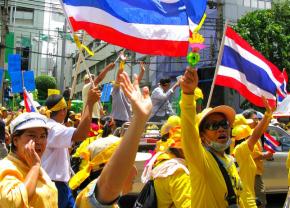Who’s behind Thailand’s protests?
Though many Western newspapers describe the forces behind protests in Thailand as "pro-democracy," their history shows they are anything but, argues.
THAILAND'S ONGOING political crisis took a turn for the worse on August 26 when anti-government protesters took over government buildings, set up roadblocks and forced a state-run television station off the air.
The protests are led by the People's Alliance for Democracy (PAD), a movement headed by media tycoon and multimillionaire Sondhi Limthongkul. Despite its name, the PAD is a vehicle primarily for the urban middle and upper classes, described by the Bangkok Post as the "blue blood jet set."
The PAD first achieved international prominence in the coup of September 2006, when it, along with sections of the military, overthrew the democratically elected government of Prime Minister Thaksin Shinawatra. Thaksin was the founder of the populist Thai Rak Thai Party (roughly translated as the Thai Unity Party), which had led the government since 2001.
Founded in the late 1990s on a platform of debt relief, subsidies to farmers and universal health care, Thai Rak Thai's tenure in power was marked by an ambiguous legacy.

On the one hand, Thaksin followed through on his health care plan and created a system of universal coverage that expanded health care access from 76 percent of the population to 96 percent, as well as providing low-cost access to HIV/AIDS medication. On the other hand, Thaksin went ahead with various neoliberal and free-trade agreements that threatened to undermine the progress made, especially with respect to Thailand's ability to manufacture generic HIV/AIDS medication.
Even more disturbing was Thaksin's record as a vicious prosecutor of the international war on drugs. In his first term in office, over 3,000 suspects were executed without ever coming to trial.
Discontent with Thai Rak Thai's human rights abuses and neoliberal policies resulted in a growing protest movement. In 2004, protests of 200,000 workers helped delay an energy privatization plan pushed by Thaksin.
Seeing an opportunity in the political instability, upper-class forces created the PAD in an attempt to channel people's anger at Thaksin into safer channels. Given the historic weakness of the Thai left, the PAD was able to absorb large layers of the protest movement without significant challenge. Embracing an end to political corruption as its slogan, the PAD sought to remove Thaksin from power and replace him with a less dangerously populist figure.
The PAD's accusations of government corruption were ironic, given that Thaksin's regime had seen a decrease in political corruption, and the 2005 re-election of Thai Rak Thai was marked by the largest voter turnout in voter history, as well as a massive reduction in vote-buying.
In order to explain Thai Rak Thai's apparent popularity, the PAD argued that the party had "tricked the ignorant rural poor" into voting for it. This was, as Thai Marxist Giles Ji Ungpakorn argues, "a convenient justification for ignoring the wishes of 16 million people."
THE PAD achieved victory in September 2006, when a military junta took control of Bangkok while Thaksin was visiting New York. The junta relied on the twin support of the PAD and the Thai royalty. Thai Rak Thai party members came under repression, and many resigned.
The coup regime, renaming itself the Council for Democratic Reform (CDR), immediately instituted a massive censorship campaign. Heads of television stations were instructed to carry no news reporting on public opinion. Three hundred community radio stations were ordered to cease broadcasting. The CDR issued an ominous announcement that it would "urgently retaliate against foreign reporters whose coverage has been deemed insulting to the monarchy" (in whose name the CDR governed).
The junta promised elections within 12 months of its seizure of power. To combat the still massive popularity of Thaksin and Thai Rak Thai, the party was officially dissolved and banned.
Elections were scheduled for December 2007. In an attempt to regain power, many prominent Thai Rak Thai members agreed to stand in the elections on the People's Power Party (PPP) ticket, a right-wing party headed by Samak Sundaravej, a former governor known for his brutality in repressing protests.
The PPP would go on to win the elections, and Samak became prime minister. Thai Rak Thai members did exercise some influence in the party however, leading Sondhi and the PAD to describe Samak's government as a proxy for Thaksin.
It is this charge that has been the prime motivator behind this latest round of protests. Though many Western newspapers have been describing the protest forces as "pro-democracy," their history shows that they are anything but.
Additionally, the PAD currently has close ties to Gen. Saprang Kalayanamitr, a key player in the 2006 coup who was passed over for Army chief general. Saprang represents the extreme right wing of the Thai military and has been quoted in newspapers saying he will shoot his political opponents himself. Recently, he told Thai papers that he is personally giving orders to the PAD.
Contrary to their image in the Western media, the protests in Thailand are not a movement for democracy. They represent an attempt by the extreme right wing of Thai politics to gain even greater influence in the government.
Without an independent left, Thai workers' anger over neoliberalism has been hijacked by ruling-class forces intent on forcing through even more brutal attacks on the people's living standards.


